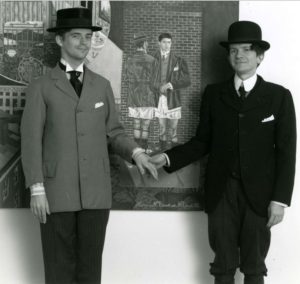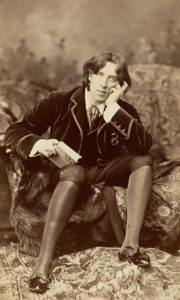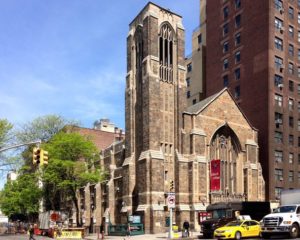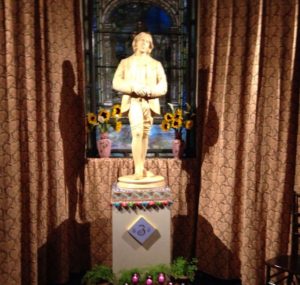OSCAR WILDE TEMPLE TIMELINE
1797: The Duane Street Methodist Episcopal Church was founded.
1854 (October 16): Oscar Fingal O’Flahertie Wills Wilde was born.
1900 (November 30): Oscar Wilde died from meningitis in Paris, France.
1952: David McDermott was born in Hollywood, California.
1958: Peter McGough was born in Syracuse, New York.
1980: McDermott & McGough began their artistic collaboration.
2005: The Church of the Village was established.
2017: Wilde was among an estimated 50,000 men who were pardoned for his offense (gross indecency with men), which was eliminated as a crime in the U.K.
2017 (September-December): McDermott & McGough unveiled the Oscar Wilde Temple at the Church of the Village.
FOUNDER/GROUP HISTORY

David McDermott was born in Hollywood, California in 1952 and Peter McGough was born in Syracuse, New York in 1958. [Image at right] Although both were students at Syracuse University, they did not actually meet until several years later in New York. They began collaborating as artists in 1980. The pair gained public visibility in the 1980s for their unique approach to art and life, recreating the Victorian era in both their art and personal lives. As Green (2013) describes their lifestyle:
They were the dandies of Avenue C, swanning about in cutaway suit coats, top hats and detachable starched collars. They made paintings the old-fashioned way, dressed in smocks and using rabbit skin glue primer and lead gesso on linen tacked, rather than stapled, to stretchers they found in the garbage. They backdated their work to the early 1900s, or before…. Even their habitats were in the past tense, with 19th-century furniture and wallpaper, illuminated by candles and often without heat or plumbing.
They referred to their artwork as “time maps” and a “time portal.” They planned the establishment of the Oscar Wilde Temple for two decades.
The Oscar Wilde Temple honors Irish author and playwright Oscar Fingal O’Flahertie Wills Wilde, a iconoclastic, flamboyant figure and prolific author, journalist and playwright (Belford 2000; Ellmann 1988; Friedman 2014; Kaufman  1999). [Image at right] Among his most noted works are The Picture of Dorian Gray and The Importance of Being Earnest. Wilde was born into a prominent Dublin, Ireland family, the second of three children. He attended Trinity College in Dublin and then Magdalen College, Oxford where he began to identify with the aestheticism and decadence movements. Wilde met and later married Constance Lloyd. The couple had two sons. While married Wilde began a relationship with Michael Ross.
1999). [Image at right] Among his most noted works are The Picture of Dorian Gray and The Importance of Being Earnest. Wilde was born into a prominent Dublin, Ireland family, the second of three children. He attended Trinity College in Dublin and then Magdalen College, Oxford where he began to identify with the aestheticism and decadence movements. Wilde met and later married Constance Lloyd. The couple had two sons. While married Wilde began a relationship with Michael Ross.
For a time, Wilde was buffered from stigmatization by his fame and wealth. Yet his vulnerability is evidenced by the fact that his precipitous public downfall occurred at a moment when he was riding a wave of considerable fame. His troubles began when he brought legal charges against John Douglas, the Marquess of Queensbury, who was the father of his partner, Lord Alfred Douglas, for criminal libel. The father had confronted Lord Alfred Douglas about the relationship and directly threatened to expose Wilde for committing sodomy. Wilde responded to the threats by bringing legal charges against the John Douglas for criminal libel. Although Wilde ultimately dropped the criminal libel charges, he himself was subsequently arrested and charged with gross indecency with men. He chose to stand trial rather than leave England for France. In court, confronted with evidence of his gay lifestyle, Wilde was unrepentant:
Asked by prosecutor Charles Gills to define the “love that dare not speak its name” during his infamous trial for sodomy and gross indecency, Oscar Wilde responded, “It is beautiful, it is fine, it is the noblest form of affection. There is nothing unnatural about it. It is intellectual, and it repeatedly exists between an older and a younger man, when the older man has intellect, and the younger man has all the joy, hope and glamour of life before him. That it should be so, the world does not understand. The world mocks at it and sometimes puts one in the pillory for it.” In refusing to flee to Paris, hide or demean his sexuality, Wilde essentially made himself a martyr. Oscar Wilde died for our sins (Colluci 2017).
After extended judicial procedures, Wilde was found guilty; the verdict was attended by harsh condemnation from the judge and public humiliation and censure. He was sentenced to the statutory maximum of two years of penal labor. Prison life took a toll on his health and spirit. During his incarceration Wilde chronicled those experiences in “De Profundis” (1897) and “The Ballad of Reading Gaol” (1898).
Wilde left Britain for France immediately and permanently after his release from prison. For the three remaining years of his life, Wilde lived an impoverished existence in Paris, having little means of support and few supporters. He contracted meningitis and died of meningitis on November 30, 1900. Recently, Wilde was one of approximately 50,000 men pardoned for previously criminalized homosexual conduct (Bowcott 2017). The general law under which Wilde was pardoned (the 2017 Policing and Crime Act) was based on a pardon granted to Alan Turning, who became famous for breaking German secret military codes in World War II but later committed suicide after being convicted for “gross indecency.”
MISSION/PHILOSOPHY
For designers McDermott & McGough, Wilde embodies the suppression of LBGT sexual expression and the struggle against persecution. Celebrating Wilde’s life anchors the LGBT struggle for liberation in the Victorian era, well before Stonewall (Small 2017). As Greenberger (2017) puts the matter, “Forced to repress his homosexuality for the majority of his life, Wilde is presented in McDermott & McGough’s piece as a martyr of sorts—a soul who suffered because of what he believed and who he was.” Therefore, although presented in a church sanctuary, the Oscar Wilde Temple is designed “to be a place free of religious doctrine, honoring a watershed historical figure who pioneered the long struggle for equal rights for gays, lesbians, bisexual, and transgender peoples—a struggle that has intersected with our nation’s larger effort to acknowledge, accept, embrace, and draw strength from the profound diversity that makes society stronger and enriches the lives of all people” (Greenberger 2017). While the temple may be designed to be free of “religious doctrine,” there is considerable religious symbolism. As Burton (2017) notes:
And although the Oscar Wilde Temple isn’t technically a religious worship space, it certainly provides a space for LGBTQ people — some of whom may have been excluded from traditional religious settings — to participate in acts and rituals that certainly qualify as religious….Here, they can reflect on the experiences of heroes and martyrs in their own tradition, following Wilde through his own “stations of the cross” just as a Christian might do in a more traditional church, engage in communal celebration, and mark important lifetime rituals: from birth to death.
ORGANIZATION
The Oscar Wilde Temple is being hosted in New York’s United Methodist Church of the Village, which is located in  Greenwich Village. The Church of the Village was formed in 2005 through a merger of three United Methodist churches: Nations, Metropolitan-Duane, [Image at right] and Washington Square. The Metropolitan-Duane United Methodist Church, where the congregation meets, is an historic church that ultimately traces its roots back to the the Duane Street Methodist Episcopal Church, which was founded in 1797 (New York City Chapter of the American Guild of Organists website n.d.). The Church of the Village describes itself as “a progressive, radically inclusive, and anti-racist United Methodist church.” Its mission “includes celebrating human diversity and embracing radical inclusivity.” The church welcomes “people of every color, nationality, sexual orientation, gender identity, expression, economic status, and mental and physical ability” (Church of the Village website n.d.). The church hosted the founding chapter of Parents and Friends of Lesbians and Gays in 1973.
Greenwich Village. The Church of the Village was formed in 2005 through a merger of three United Methodist churches: Nations, Metropolitan-Duane, [Image at right] and Washington Square. The Metropolitan-Duane United Methodist Church, where the congregation meets, is an historic church that ultimately traces its roots back to the the Duane Street Methodist Episcopal Church, which was founded in 1797 (New York City Chapter of the American Guild of Organists website n.d.). The Church of the Village describes itself as “a progressive, radically inclusive, and anti-racist United Methodist church.” Its mission “includes celebrating human diversity and embracing radical inclusivity.” The church welcomes “people of every color, nationality, sexual orientation, gender identity, expression, economic status, and mental and physical ability” (Church of the Village website n.d.). The church hosted the founding chapter of Parents and Friends of Lesbians and Gays in 1973.
The Oscar Wilde Temple was installed in the Church of the Village as a partnership project involving the church and the Lesbian, Gay, Bisexual & Transgender Community Center of New York City. The Temple is located in the church’s Russell Chapel and was unveiled in September 2017. The temple is designed to recreate the 1880s Victorian environment in which Wilde lived and worked:
Specially made fabric wall coverings, architectural and decorative details, furnishings and lighting exemplify the longstanding art-life practice that the duo has described as a “time experiment,” in which the boundaries of chronology, art history, and cultural identity are strategically upended in order to open the minds of viewers to universal themes, aesthetic discoveries, and spiritual byways (The Oscar Wilde Temple n.d.).
At the center of the display is a four-foot statue of Oscar Wilde. Flanking the statue are paintings (“stations”) recreating  Wilde’s passage through arrest, trial, and imprisonment. A second alter honors individuals who are presented as “martyrs” of homophobia and AIDS. Accompanying the second alter are portraits by McDermott & McGough of some of the more famous of these individuals: Alan Turing, Harvey Milk, Marsha P. Johnson, Brandon Teena, Xulhaz Mannan, and Sakia Gunn.
Wilde’s passage through arrest, trial, and imprisonment. A second alter honors individuals who are presented as “martyrs” of homophobia and AIDS. Accompanying the second alter are portraits by McDermott & McGough of some of the more famous of these individuals: Alan Turing, Harvey Milk, Marsha P. Johnson, Brandon Teena, Xulhaz Mannan, and Sakia Gunn.
IMAGES
Image #1: Photograph of David McDermott and Peter McGough.
Image #2: Photograph of Oscar Wilde.
Image #3: Photograph of the Metropolitan-Duane United Methodist Church.
Image #4: Photograph of the Oscar Wilde Chapel in the Village Church.
REFERENCES
Belford, Barbara. 2000. Oscar Wilde: A Certain Genius. New York: Random House.
Bowcott, Owen. 2017. “UK Issues Posthumous Pardons for Thousands of Gay Men.” The Guardian, January 31. Accessed from https://www.theguardian.com/world/2017/jan/31/uk-issues-posthumous-pardons-thousands-gay-men-alan-turing-law.
Burton, Tara. 2017. “New York’s Oscar Wilde Temple Makes a Saint Out of an LGBTQ Icon.” Vox, September 14. Accessed from https://www.vox.com/identities/2017/9/14/16290048/new-york-oscar-wilde-temple-lgbtq-mcdermott-mcgough on 4 October 2017.
Colucci, Emily. 2017. “Every Saint Has A Past And Every Sinner Has A Future: Worshiping At McDermott & McGough’s The Oscar Wilde Temple.” Filthy Dreams, September 17. Accessed from https://filthydreams.wordpress.com/2017/09/17/every-saint-has-a-past-and-every-sinner-has-a-future-worshiping-at-mcdermott-mcgoughs-the-oscar-wilde-temple/ on 3 October 2017.
Ellmann, Richard. 1988. Oscar Wilde. New York: Alfred A. Knopf
Friedman, David. 2014. Wilde in America. New York: W. W. Norton.
Green, Penelope. 2013. “Living in Sepia.” New York Times, January 30. Accessed from http://www.nytimes.com/2013/01/31/garden/to-peter-mcgough-living-in-an-earlier-era-is-art.html on 3 October 2017.
Greenberger, Alex. 2017. “McDermott & McGough to Open Temple Dedicated to Oscar Wilde in New York’s Church of the Village.” Accessed from http://www.artnews.com/2017/07/19/mcdermott-mcgough-to-open-temple-dedicated-to-oscar-wilde-in-new-yorks-church-of-the-village/ on 27 September 2017.
Kaufman, Moises. 1999. Gross Indecency: The Three Trials of Oscar Wilde. New York: Dramatist Play Service.
New York City Chapter of the American Guild of Organists website. n.d. Accessed from
http://www.nycago.org/Organs/NYC/html/ChurchoftheVillage.html on 27 September 2017.
Small, Zachary 2017. “A Queer Temple in New York Pays Tribute to Oscar Wilde.” Artsy, September 12. Accessed from https://www.artsy.net/article/artsy-editorial-queer-temple-new-york-pays-tribute-oscar-wilde on 3 October 2017.
Team Gallery. n.d. “Hollywood (Homosexual) Hopeful.” Accessed from http://www.teamgal.com/exhibitions/367/hollywood_homosexual_hopeful on 26 September 2017.
The Oscar Wilde Temple website. n.d. “The Temple.” Accessed from https://www.oscarwildetemple.org/the-temple/ on 27 September 2017.
Post Date:
5 October 2017
